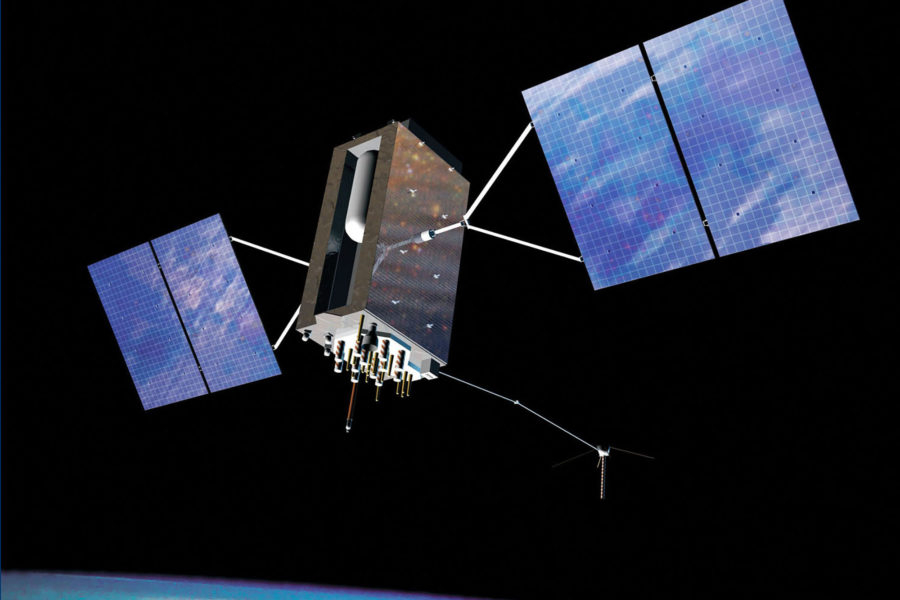The Air Force has the F-22 Raptor. The Navy has its Nimitz-class (CVN-68) aircraft carriers. The Army has the M2 Bradley Fighting Vehicle. Now the Space Force wants in on the name game, and is planning to start naming its satellites, radars, and other weapons recognizable names.
Guardians can help. Chief of Space Operations Gen. B. Chance Saltzman’s latest “C-Note” memo to Guardians went out Oct. 25, inviting Guardians to put their heads together to come up with the best ways to identify USSF spacecraft.
“How do we talk about our equipment in the Space Force?” Saltzman asked. “How do we name the systems we operate? Do those names accurately reflect the Guardian spirit—the space warfighting culture that we are working to build? I am not convinced that they do. But we are making strides to rectify that.”
Space Force systems are typically known by clunky, unpronouncable acronyms—SBIRS for Space-Based Infrared System, or GSSAP for Geosynchronous Space Situational Awareness Program, or SCN for Satellite Control Network. Naming them could make them more memorable and recognizable to the public.
Last October, the Space Force established a new designation system for future platforms with Space Force Instruction 16-403, but that move did nothing to change existing naming conventions. “It is a tremendous step to move from where we are today,” Saltzman wrote in his C-Note, “to a world in which all our systems are named to reflect the culture of their operators.”
The CSO asked Guardians to share ideas for satellite naming “themes” by Nov. 30. To prime the pump, he offered ideas of his own: “For example, should we name the systems within our Missile Warning and Tracking activities after birds of prey? Or systems within SATCOM activities after canines? Should we leverage mythology? Natural phenomena?”
Saltzman listed 10 activities of interest:
- Cyber warfare
- Electromagnetic warfare
- Missile Warning and Tracking
- Navigation Warfare
- Orbital Warfare
- Reconnaissance
- Satellite Communications
- Space-Based Sensing and Targeting
- Surveillance
- Theater Electromagnetic Warfare
The service is not looking for names of specific platforms at this stage, but themes for these specific categories, an official told Air & Space Forces Magazine. Names could come later, once themes are selected.
Saltzman directed Guardians to read Space Force Instruction 16-403 before submitting suggestions. That document, released with little fanfare last fall and updated in July, sets requirements: Names should be “no more than two short words,” must not infringe on any copyrights (take note, Sci-Fi fans), and must not sound like the names of some existing weapons system; names should also be “within scope of DOD values and morals.”
The designation system for Space Force weapons is similar to the Tri-Service Aircraft Designation System. The first component describes the mission and environment of the system, while the second component signifies “the design number and the design series.” The system also includes optional prefixes if the system is experimental, a prototype, or has an otherwise modified mission.
For instance, a communications satellite constellation located in low-Earth orbit, like the one being developed by the Space Development Agency, could be designated CL-1 or some other design number. GPS, a navigation warfare system in medium-Earth orbit, could be designated NM-3 or some other number.
The instruction notes that the designation system will only be required for new systems developed after October 2023, to include systems currently in development. Each system will require a designation no later than preliminary design review, and a designation and popular name prior to System Fielding Decision.
However, Guardians can request that today’s fielded systems also receive a designation and name, the instruction notes.
Space Force Weapons System Designations
| Modified Mission (optional) | Basic Mission | Environment |
|---|---|---|
| T – Test/Training/Range | A – Attack | C – Cyberspace |
| Y – Prototype | B – Battle Management | D – Deep Space |
| X – Experimental | C – Communications | G – Geosynchronous Orbit |
| Z – Scientific/Calibration | D – Defend | M – Medium-Earth Orbit |
| E – Electromagnetic Warfare | H – Highly Elliptical Orbit | |
| K – Support | L – Low-Earth Orbit | |
| M – Meterological | T – Terrestrial | |
| N – Navigation Warfare | V – Various | |
| P – Pursuit | ||
| R – Reconnaissance | ||
| S – Surveillance | ||
| W – Warning & Tracking |

